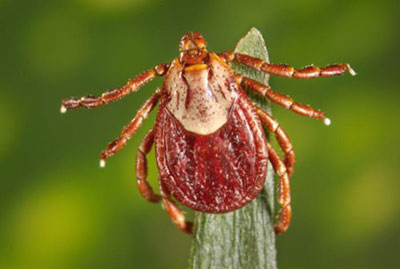Rocky Mountain Wood Tick
(Dermacentor andersoni)

The Rocky Mountain Wood tick (Dermacentor andersoni) has a similar appearance to the American dog tick but can be distinguished by its bright red, tear drop shaped body. Females will have a white colored shield and males will have gray and white spots on their body. They are primarily located in the Rocky Mountain States of Nebraska, South Dakota, Arizona, New Mexico, and California. Lower elevations will typically lead to high population densities.
The Tick Research Lab of Pennsylvania is able to detect the most common tick-borne diseases in any of these species. Our tick DNA tests are over 99.9% accurate.
Details
Rocky Mountain Tick Habitat
The common name for this tick is the wood tick because of its preference for a wooded habitat with low-growing vegetation, around trails and grasslands.

Rocky Mountain Tick Life Cycle
Rocky Mountain Wood ticks are known to live up to 3 years where they undergo 3 stages of life. Each life stage requires a blood meal from a mammalian host prior to molting into the next stage.
Rocky Mountain Tick Behavior
Wood ticks are most active from March-July when warmer weather beings in early spring. Similar to other species of tick, the immature life stages will feed on small to medium sized animals, whereas the adults will quest for larger mammals such as sheep, humans, and deer.
Are Rocky Mountain Ticks a Threat?
The rocky mountain wood tick is able to cause a sickness called tick paralysis. A neurotoxin present in the saliva will be injected into the host if the tick is attached and feeding for a long enough period of time. Current research suggests the ability for a wood tick to cause tick paralysis is inherited and therefore only exists in certain populations.
Typically, ataxia and paralysis will start at the feet and move up the body. If the tick is removed in time, the symptoms will subside after a day or two. However, if the tick remains attached and paralysis is able to move into the lungs, breathing may become difficult and lead to more severe symptoms.

